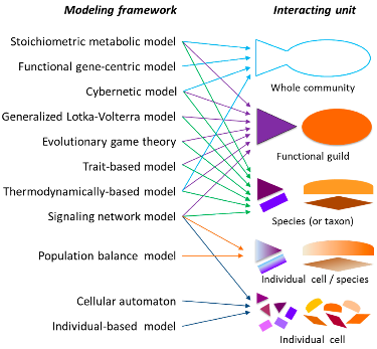
Mathematical framework of microbial models
can depend on the representative interacting unit. (Courtesy of Song, H.-S. et al., Processes, 2(4), 711, 2014,
Figure 2.)
Scientific Achievement
This chapter summarizes traditional thermodynamic- based microbial modeling approaches as well as next generation population-based methods that are aimed at improving our understanding of function, dynamics, and emergence in microbial ecosystems.
Significance and Impact
Modelers seeking to incorporate microbially mediated reactions into their codes will find a description of traditional and emergent approaches, example applications, and current limitations.
Research Details
- Provided a description of traditional thermodynamic-based models and two emergent approaches, functional trait-based models and dynamic energy partitioning models, including example applications, for describing microbial community dynamics within the subsurface environment.
- Presented an overview of current obstacles to implementation of these microbial population-based models and suggested opportunities for the integration of culture-independent (meta-omic) and culture-dependent experiment to structure and parameterize these models.
Citation
Arora, B., Cheng, Y., King, E., Bouskill, N. and Brodie, E., 2017. 27 Modeling Microbial Energetics. Handbook of Metal-Microbe Interactions and Bioremediation, p.445.
